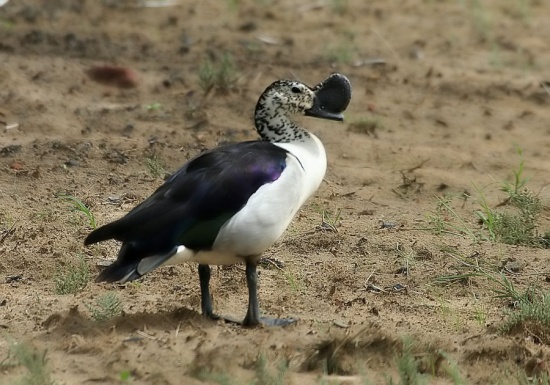(Flight & Juvenile pictures. Attempt to disguise copied text. References) |
(Some extra info. References updated. Video link.) |
||
| Line 2: | Line 2: | ||
;[[:Category:Sarkidiornis|Sarkidiornis]] melanotos | ;[[:Category:Sarkidiornis|Sarkidiornis]] melanotos | ||
==Identification== | ==Identification== | ||
| + | American: 64–79 cm (25-31 in); African: 55–63 cm (21-25) | ||
*Glossy blue black upperparts | *Glossy blue black upperparts | ||
*White underparts | *White underparts | ||
| Line 29: | Line 30: | ||
The species is sometimes split with ''sylvicola'' as '''Comb Duck''' and ''melanotos'' as '''Knob-billed Duck'''. | The species is sometimes split with ''sylvicola'' as '''Comb Duck''' and ''melanotos'' as '''Knob-billed Duck'''. | ||
==Habitat== | ==Habitat== | ||
| − | Wetlands, freshwater swamps and lakes. | + | Wetlands, freshwater swamps, rice fields and lakes. |
==Behaviour== | ==Behaviour== | ||
====Diet==== | ====Diet==== | ||
| − | The diet | + | The diet for both subspecies is mostly vegetarian, with grass, seeds and rice grain; supplemented with small fish and invertebrates. |
====Breeding==== | ====Breeding==== | ||
They nest in tree holes and tall grass. The nest is lined with reeds, grass, or feathers. 7-15 yellowish-white eggs are laid; incubated by the female for about 30 days. | They nest in tree holes and tall grass. The nest is lined with reeds, grass, or feathers. 7-15 yellowish-white eggs are laid; incubated by the female for about 30 days. | ||
==References== | ==References== | ||
| − | #{{Ref- | + | #{{Ref-Clements6thAug14}}#{{Ref-Hockeyetal05}}#Handbook of the Birds of the World Alive (retrieved June 2015) |
{{ref}} | {{ref}} | ||
==External Links== | ==External Links== | ||
{{GSearch|Sarkidiornis+melanotos}} | {{GSearch|Sarkidiornis+melanotos}} | ||
| + | <br /> | ||
| + | {{Video|Comb_Duck}} | ||
| − | [[Category:Birds]] [[Category:Sarkidiornis]] | + | [[Category:Birds]] [[Category:Sarkidiornis]] [[Category:Videos]] |
Revision as of 19:44, 19 June 2015
- Sarkidiornis melanotos
Identification
American: 64–79 cm (25-31 in); African: 55–63 cm (21-25)
- Glossy blue black upperparts
- White underparts
- Blue and green iridescent secondaries
- White head with dark spots
- White neck
Male - larger with large black knob on the bill
Juvenile
- Dull buff underparts, face and neck
- Dull brown upperparts, crown and eyestripe
Distribution
Sub-Saharan Africa, Madagascar, south Asia, Pakistan, Laos and extreme southern China.
Also eastern Paraguay, southeastern Brazil, northeast of Argentina.
Has been reported as a vagrant on Trinidad.
Taxonomy
Subspecies
Sarkidiornis melanotos has two subspecies:[1]
- S. m. melanotos
- Tropical Africa, Madagascar and Pakistan to southern China
- S. m. sylvicola
- Tropical South America (east of the Andes)
The species is sometimes split with sylvicola as Comb Duck and melanotos as Knob-billed Duck.
Habitat
Wetlands, freshwater swamps, rice fields and lakes.
Behaviour
Diet
The diet for both subspecies is mostly vegetarian, with grass, seeds and rice grain; supplemented with small fish and invertebrates.
Breeding
They nest in tree holes and tall grass. The nest is lined with reeds, grass, or feathers. 7-15 yellowish-white eggs are laid; incubated by the female for about 30 days.
References
- Clements, J. F., T. S. Schulenberg, M. J. Iliff, D. Roberson, T. A. Fredericks, B. L. Sullivan, and C. L. Wood. 2014. The eBird/Clements checklist of birds of the world: Version 6.9., with updates to August 2014. Downloaded from http://www.birds.cornell.edu/clementschecklist/download/
- Hockey, PAR, WRJ Dean, and PG Ryan, eds. 2005. Roberts' Birds of Southern Africa. 7th ed. Cape Town: John Voelcker Bird Book Fund. ISBN 978-0620340533
- Handbook of the Birds of the World Alive (retrieved June 2015)
Recommended Citation
- BirdForum Opus contributors. (2024) Comb Duck. In: BirdForum, the forum for wild birds and birding. Retrieved 25 April 2024 from https://www.birdforum.net/opus/Comb_Duck
External Links






